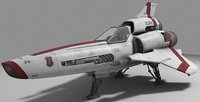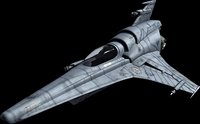Viper (TRS)
More languages
More actions
- This article discusses the two Viper-class fighters seen in the Re-imagined Series. Detailed information for each fighter can also be found in Viper Mark II and Viper Mark VII. For information on the Viper used in the Original Series and in Galactica 1980, see Viper (TOS).
The Viper is the Colonial Fleet's primary space superiority fighter / attack craft.


The Viper was originally introduced into Colonial service shortly before the outbreak of the Cylon War. After the war, newer models, such as the Mark VII, replaced the Mark II.
The Mark II served with distinction throughout the Cylon War, but was subsequently superseded by newer models. At the time of the renewed Cylon attack on the Twelve Colonies, the Mark VII was the front-line variant of the Viper design.
Atmospheric Operations
The Viper is designed for atmospheric as well as space-based operations. However, Vipers consume more fuel during atmospheric operations than in the vacuum of space. Once in an atmosphere, the engines must run continuously to maintain sufficient airflow over the wing lifting surfaces. Depending on the composition of the atmosphere itself, this can place severe strain on the Viper's engines (You Can't Go Home Again). In addition to excessive fuel consumption in atmospheric flight, the very high wing loading (a very small wing area relative to their weight) may compromise the Viper's overall atmospheric manueoverability. Because of the smaller wings (which generate less lift) higher speeds may be needed just to stay in the air. It is probable that the fighter's reaction control thrusters may offset one or both of these problems.
Life Support
Viper cockpits are pressurised and heated, but they are flown with the pilot wearing a flight suit that provides full life support should ejection be required (You Can't Go Home Again). A life support backpack is built into the pilot's seat itself. During an ejection, the back of the seat separates automatically, effectively becoming a backpack for the pilot using the seat's harnesses as straps (Act of Contrition).
Should ejection take place within an atmosphere, the life support backpack also incorporates a parachute.
Life support systems do not include artificial gravity, inertial dampeners, or the like, so pilots are actually exposed to the effects of acceleration. To prepare for the strains this causes on the body, battlestars have a specialized Weight Room.
Crew
- Pilot in Terrell ES 24C ejection seat. [1]
See Also
- Viper Mark II: Detailed information on the older Mark II fighter.
- Viper Mark VII: Detailed information on the newer Mark VII fighter.
Sources
- ↑ Ejector seat details from David Bassom's Battlestar Galactica: The Official Companion.
External links
- Viper at Wikipedia.
